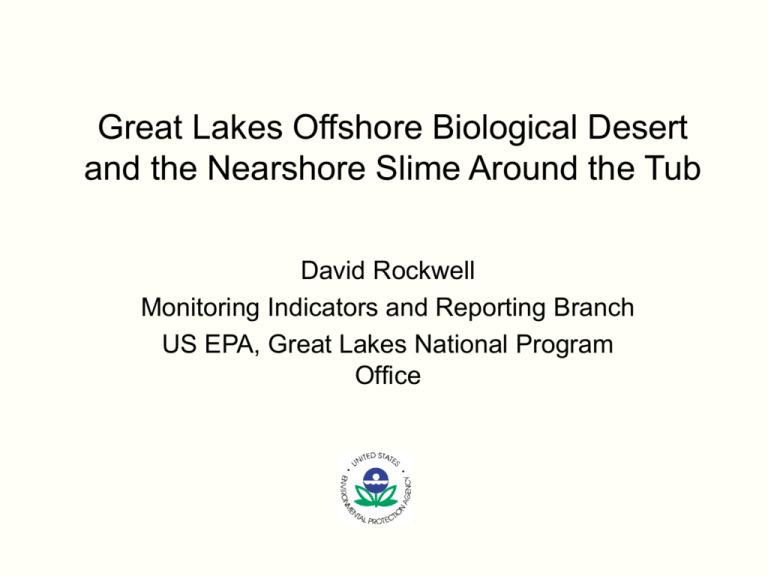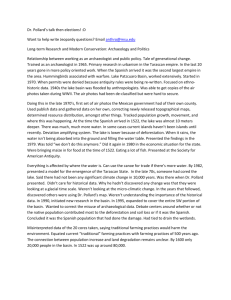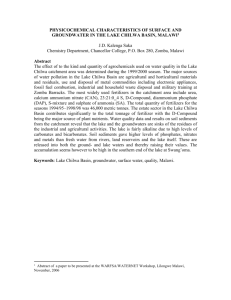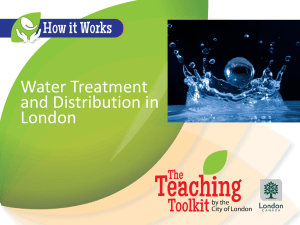MP3
advertisement

Great Lakes Offshore Biological Desert and the Nearshore Slime Around the Tub David Rockwell Monitoring Indicators and Reporting Branch US EPA, Great Lakes National Program Office Methods • Great Lakes National Program Office • Annual monitoring cruises, 1983-2005 – Spring unstratified (April) – Summer stratified (August) GLNPO Biology Program Measures • Phytoplankton – Community Composition, Biomass – Deep Chlorophyll Maximum – Historical Communities • Crustacean Zooplankton and Benthos – Community Composition – Size Structure of Community GLNPO Sampling Stations Different colors indicate regions assumed to be homogeneous Methods • 1984-1990: – Tows B-2 m – 63 mm mesh net with flowmeter – Biomass calculated from avg. length/spp generated from 20 m tows • 1998-2005 – 100 (or B-2 m) tows – 153 mm mesh net with flowmeter – 20 individuals/spp measured/sample Zooplankton Communities in Lake Huron 1984-2005 Mary Balcer University of Wisconsin-Superior Richard P. Barbiero CSC, & Loyola University Chicago Biomass mg/m3 Total crustacean biomass with standard error bars 60000 Northern Basin 40000 20000 0 1984 1986 1988 1990 1992 1994 1996 1998 2000 2002 2004 160000 140000 Southern Basin Biomass mg/m3 120000 100000 80000 60000 40000 20000 0 1984 1986 1988 1990 1992 1994 1996 1998 2000 2002 2004 Cladocerans Copepods #3 #1 Cyclopoid copepod Daphnia #2 Bosmina Bosmina Diaptomid copepod Limnocalanus 3 Biomass (mg/m ) Biomass of major taxonomic groups 40000 Huron North basin 20000 0 1984 1986 1988 1990 1992 1994 1996 1998 2000 2002 2004 2006 120000 Huron South basin 3 Biomass (mg/m ) 100000 80000 60000 40000 20000 0 1984 1986 1988 1990 1992 1994 1996 1998 2000 2002 2004 2006 immature calanoids adult calanoids immature cyclopoids adult cyclopoids predatory clads daphnid clads non daphnid clads Diporeia Decline Northern Basin 3000 1000 0 1998 1999 2000 2001 2002 2003 2004 2005 Southern Basin 2500 1500 1000 500 0 1999 2000 2001 2002 2003 2004 2005 Diporeia abundance (#/m2) 2000 1998 Diporeia abundance (#/m2) 2000 Diporeia Decline 30000 Northern Basin Biomass mg/m3 3000 20000 2000 15000 10000 1000 5000 0 0 1998 1999 2000 2001 2002 2003 2004 Diporeia abundance (#/m2) 25000 2005 120000 Southern Basin Biomass mg/m3 2500 2000 80000 1500 60000 40000 1000 20000 500 0 0 1998 1999 2000 2001 2002 2003 2004 2005 Diporeia abundance (#/m2) 100000 Size distribution of crustacean biomass 6000 1998 5000 immature calanoids adult calanoids immature cyclopoids adult cyclopoids predatory clads daphnid clads South Basin 4000 3000 2000 1000 0 12000 1999 11000 non daphnid clads 10000 6000 1998 5000 9000 North Basin 4000 8000 7000 3000 6000 2000 5000 1000 4000 6000 0 3000 1999 5000 2000 4000 1000 0 6000 3000 2000 2001 5000 1000 4000 4000 0 3000 2001 3000 2000 2000 1000 1000 6000 0 6000 0 2002 5000 2002 5000 4000 4000 3000 3000 2000 2000 1000 1000 3000 0 3000 0 2003 2000 2003 2000 1000 1000 2000 0 2000 0 2004 1000 2004 1000 0 2000 2000 0 2005 1000 2005 1000 0 0 0 1 2 Length (mm) 3 4 0 1 2 Length (mm) 3 4 Lake Huron and Lake Superior Zooplankton Communities 3 Biomass (mg/m ) Superior central basin 2004 2000 1000 0 0 1 2 3 4 Huron northern basin 3 Biomass (mg/m ) Length (mm) 2005 2000 1000 Limnocalanus macrurus 0 0 1 2 3 4 Length (mm) Diaptomus sicilis 8000 Phosphorus Loading Trends Superior 6000 GLWQA Target 4000 Recent Loads Dolan and McGunagle 2005 0 30000 8000 Erie Michigan 6000 20000 4000 10000 2000 0 0 8000 15000 Ontario Huron 6000 10000 4000 5000 2000 2005 2000 1995 1990 1985 1980 1975 1970 2005 2000 1995 1990 1985 1980 1975 1970 1965 0 0 1965 P Load (tonnes yr-1) 2000 Total Phosphorus Trends (Spring) 8 Harvey Bootsma SOLEC 2006 Superior GLWQA Target 6 4 ♦ ♦ Environment Canada ■ ■ USEPA-GLNPO 2 TP (mg L-1) 0 8 6 40 Michigan 4 20 2 10 0 0 30 25 20 15 10 5 0 15 Huron 10 5 0 1965 1970 1975 Erie Central 30 1980 1985 1990 1995 2000 2005 1965 Ontario 1970 1975 1980 1985 1990 1995 2000 2005 Plots of simulation results and data for TP (mgP/L) in the Upper Great Lakes: (a) Superior, (b) Michigan, and (c) Huron. The waterquality objectives are shown as dashed lines. (RWG D Annex 3 Technical Subgroup Report DePinto et al 2006) • Superior Michigan Huron Schematic of a long-term, total phosphorus model for the Great Lakes (Chapra 1977). Nearshore Shunt Hypothetical Construct Hecky et al 2004 Can.J. Fish Aquat. Sci 61 Secchi disk depths near Milwaukee, Lake Michigan Dr. Harvey Bootsman , SOLEC 2006For Outer Harbor Site 13 Annual Secchi Disk Data 10 9 Mussel invasion 8 7 6 5 4 3 Secchi (Meters) 2 1 0 1990 1992 1994 1996 1998 2000 2002 1991 1993 1995 1997 1999 2001 Median 25%-75% Non-Outlier Range OH-13 Databy source: MMSD Data provided MMSD Cladophora Lake Erie Total Phosphorus, ug-P/L Pre(1983-1989)/Post (1990-2004) Eastern Basin 50 45 40 35 30 25 20 15 10 5 0 1980 No Significant Difference 1985 1990 1995 2000 2005 2010 Central Basin 50 40 30 No Significant Difference 20 10 0 1980 1985 1990 1995 2000 2005 2010 Western Basin 50 45 40 35 30 25 20 15 10 5 0 1980 No Significant Difference 1985 1990 1995 Year 2000 2005 2010 Lake Erie Total Dissolved Phosphorus, ug-P/L Pre(1983-1989)/Post (1990-2004) 20 Eastern Basin 15 Significant Increase (p=0.021) 10 5 0 1980 1985 1990 1995 2000 2005 2010 20 Central Basin 15 Significant Increase (p<0.001) 10 5 0 1980 1985 1990 1995 2000 2005 2010 25 Western Basin 20 No Significant Difference 15 10 5 0 1980 1985 1990 1995 Year 2000 2005 2010 DRP/TP Figure courtesy of Dr. Peter Richards, Heidelberg College Maumee Cuyahoga Sandusky Grand Sandusky and Maumee River Watersheds Lake Erie Figure courtesy of Dr. Peter Richards, Heidelberg College P in Wisconsin Cropland 50 40 30 20 Average [P] (ppm) 60 10 0 1968- 1974- 1978- 1982- 1986- 1991- 199573 77 81 85 90 94 99 Bundy and Sturgul 2001 Long-term Influence of Soil P on Lake P Soil P inputs reduced after year 250 Phosphorus Density (g m-2) Soil [P] 1000 1000 Sediment [P] 100 100 P Input to soil 10 10 Water [P] P Inputs to Soil (g m-2 y-1) 10000 10000 1 1 0 500 1000 1500 2000 Years Source: S.R. Carpenter, 2005 Average [P] (ppm) P in Wisconsin Cropland 60 50 40 30 20 10 0 Soil P Storage Change (kg ha-1) 1968- 1974- 1978- 1982- 1986- 1991- 199573 77 81 85 90 94 99 5 4 3 2 1 0 1970 1975 1980 1985 1991 1994 1995 Bundy and Sturgul 2001 Long-term Influence of Soil P on Lake P Soil P budget balanced at year 250 Phosphorus Density (g m-2) Soil [P] 1000 1000 Sediment [P] 100 100 P Input to soil Water [P] 10 10 1 1 0 200 400 600 800 P Inputs to Soil (g m-2 y-1) 10000 10000 1000 Years Source: S.R. Carpenter, 2005 Summary • Offshore Declines in Zooplankton Biomass are observed Lake Huron. • Phosphorus loads and open lake phosphorus concentrations have declined in the Great Lakes in response to controls • Top down effects are observed to contribute to decline in the lower food web. • Nearshore Cladophora increases appear to be link to Dreissena invasion via increased water clarity and cycling of nutrients • Total phosphorus loading has increased soluble fraction and open lake concentrations in Lake Erie have a significant increase in soluble fraction in the spring. • Total phosphorus concentrations in the Upper Great Lakes appear to below levels modeled to exist in 1800. Dissolved Reactive Silica increases in Lakes Michigan and Huron are linked to TP declines. Dissolved Reactive Silica increases in Lake Erie are linked to predation by Dreissena Nearshore shunt of nutrients redirected to the nearshore zones of the Lakes contributing to the reemergence of Cladophora while offshore P concentrations remain low. Continued addition of P to soils may pose a challenge to the lakes well into the future. In the nearshore zone, increased water clarity has altered the relationship between P supply and algal abundance. More P abatement would benefit the nearshore zone, but would it benefit pelagic zone?







